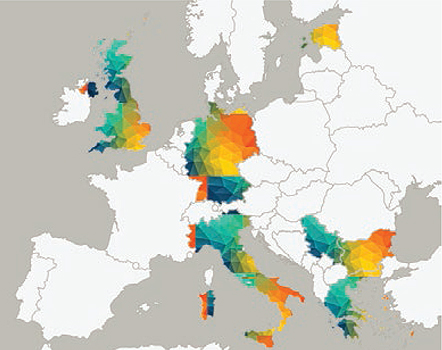Forward-looking socio-economic research on Energy Efficiency in EU countries. GA No. 649690
AIM
Taking into account that behavioral barriers demonstrated by
end users create negative deviations in EE set targets between
5-20% in EU and 20-30% globally1, the HERON project aims
at facilitating policy makers to develop and monitor Energy
Efficiency (EE) policies in building and transport sectors,
through forward-looking socio-economic research in six EU
and one candidate countries (Bulgaria, Germany, Greece,
Estonia, the United Kingdom, Italy and Serbia). The research
effort lasted for almost three years.
RESEARCH AND INNOVATION
The innovative core element is the incorporation of noneconomic
and non-market elements, such as social, educational
and cultural, into energy modeling for reflecting the end-user
behavior towards EE in the two aforementioned sectors.
Based on advanced research, surveys and questionnaire,
an innovative tool is developed providing policy makers
with the ability, for the fi rst time, to quantify the qualitative
characteristics associated with end-users’ behavioral
barriers. This user-friendly software, named as HERON
Decision Support Tool (HERON – DST) allows the calculation
of the impact of behavioral barriers on the input drivers
(technologies and policies) and the assumed targets of EE
scenarios. The tool is developed by the Energy Policy and
Development Centre (KEPA) of the National and Kapodistrian
University of Athens (NKUA) (Coordinator of the project) and
is assessed as successful and innovative by two independent
groups of EU evaluators.

HERON partners worked on deviations caused by barriers
of end-users' behavior towards EE targets and studied ways
of addressing these barriers and reducing these deviations,
through effective policies. The developed pathway of the
project facilitates its users to conclude with the preferred
scenario, among a number of optimal developed ones with
the use of the multi-criteria AMS2.
This overall HERON process (pathway), as built through the
project progress, follows these steps:
- Develop EE scenarios;
- Define the set of behavioral barriers (in relation to input drivers);
- Collect and develop a reliable qualitative data base;
- Calculate (through the HERON – DST) the impact and total impact factors of barriers;
- Calculate the emerging deviations, due to behavioral barriers, on both the input drivers and EE targets, in scenarios' analysis;
- Optimize the mixture of input drivers and final targets with HERON -DST;
- Identify the optimum EE scenario against Environmental performance, Political acceptability and Feasibility of implementation using the multi-criteria AMS;
- Conclude with a policy mixture leading to a more effective and preferable EE scenario.
IMPACT
HERON was selected by the European Commission as good
practice project, incorporating social sciences and humanities
in HORIZON 2020 projects, after a screening procedure with
the participation of 500 project coordinators.
The importance of its outcomes is quoted in an EU Commission
Staff Working Group Document (SWD/2016/0404 fi nal -
2016/0376 (COD) (Document 4, Chapter 6.2, p. 95)).
HERON is disseminated among the twelve member states of
the Black Sea Economic Cooperation organization while it is
planned to be implemented in the process of promoting EE
programmes through GCF procedures.
1. UNEP, 2016. The Emissions Gap Report 2016 – A UNEP synthesis Report. At: http://www.unep.org/emissionsgap/resources
2. Konidari P., D. Mavrakis, 2007. "A multi-criteria evaluation method for climate change mitigation policy instruments", Energy Policy 35, pages 6235-6257.
Media: www.heron2017.wordpress.com // www.heron-project.eu
Social media: www.facebook.com/HERON-project-264688910595765 // https://twitter.com/heron_project